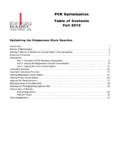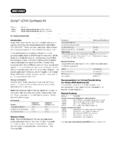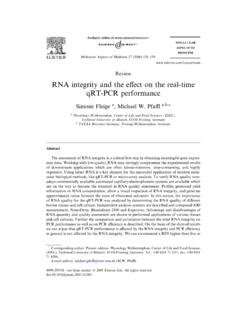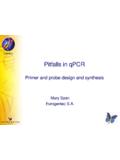Transcription of Successful PCR Guide - Separations
1 SuccessfulPCR GuideRoutine PCRReal Time PCR (qPCR) High Fidelity PCRHigh Performance PCRHot Start PCRRT-PCRPCR Cloning3rd EditionHow to Select The Best PCR Enzyme for Your Application TaKaRa Taq *Hot Start VersionTaKaRa Taq TaKaRa Ex Taq TaKaRa Ex Taq TaKaRa e2 TAK Premix Taq PrimeSTAR HS DNA Polymerase PrimeSTAR with GC Buffers PrimeSTAR Premix PrimeSTAR Premix SpeedSTAR HS DNA PolymerasePerfectShot Ex Taq One Shot LA PCR Mix LA PCR Kit Version PrimeSTAR with GC BuffersLA PCR Kit Version TaKaRa Ex Taq Hot Start Version TaKaRa LA Taq Hot Start VersionSYBR Premix Ex Taq (Perfect Real)
2 Time) Premix Ex Taq (Perfect Real Time) TaKaRa LA Taq with GC Buffers TaKaRa LA Taq TaKaRa LA Taq Premix Ex Taq Routine PCR Convenient PremixesHigh Performance PCRHot Start PCR orMultiplex PCR*High GC Content orSecondary StructuresHighFidelity PCRLong PCRHigh Speed PCRReal Time PCRFor Longer PCRHigh Sensitivity PCRFor Direct ElectrophoresisRoutine PCRHigh Fidelity PCRP remix Ex Taq HSPremix Taq HSHot Start PCR *Hot start enzymes contain an anti-Taq antibody to minimize non-specific amplification Successful PCR GuideTakara Bio USA1 Table of ContentsTable of ContentsChapter 1.
3 Points to Consider ..3 Chapter 2:Routine PCR ..7 Chapter 3:Real Time PCR (qPCR) ..11 SYBR Detection Method Probe Detection Method Various Other MethodsChapter 4:High Fidelity 5:High Performance High Speed PCR High Yield PCR Long PCRC hapter 6:Hot Start Multiplex PCRC hapter 7:Reverse Transcriptase PCR ..31 Chapter 8:PCR Cloning ..33 PCR Related Products ..34 Appendix I:Frequently Asked Questions ..35 Appendix II:PCR Nomenclature ..39 Appendix III:Troubleshooting ..40 Appendix IV:PCR Protocols ..47 Appendix V:Technical Fact Sheet ..50 Appendix VII: Guide to TaKaRa PCR VIII:Technical Articles.
4 54 Appendix IX:Licensing ..56 Ordering Back CoverTakara Bio USA is a wholly owned subsidiary of Takara Bio Inc. andserves as the North and South American base for Takara Bio sales,marketing and support activites in those a complete description of Takara Bio USA s product offering,please visit our website at BioUSATaKaRa BioEuropeTaKaRa Biotechnology(Dalian)TaKaRa Korea BiomedicalTaKaRa Bio Bio Inc., Otsu Shiga, JapanABOUT TAKARA BIO USAT akara Bio Inc. is a world class supplier of life science researchproducts headquartered in Otsu, Shiga, Japan. Takara Bio was thefirst domestic manufacturer to introduce restriction enzymes tothe Japanese market in 1979, and has consistently developednovel, cutting edge life science technologies and products.
5 Thistalent for innovation, combined with Takara Bio s unwaveringcommitment to quality, has resulted in an outstanding line ofunique, dependable products for life science research. Takara Bio holds worldwide patents on Long and Accurate (LA)PCR, and has built a portfolio of PCR licensed high-performancePCR reagents and kits, including Ex Taq , LA Taq , PrimeSTAR ,SpeedSTAR , e2 TAK , SYBR Premix Ex Taq (Perfect Real Time)and PremixEx Taq (Perfect Real Time) .Table of ContentsSuccessful PCR GuideTakara Bio USA2 Profile of PCR Reactions1 2 3 4 5 Time (min)Temperature ( C)947255221 CycleStep 1 Initial DenaturationStepStep 2 Step 3 Begin Step 1 After 30 cycles hold at 4 CRepeat Step 1 3for 25-30 cycles105-fold amplification of target DNA fragmentPrimerannealingDenaturationStepS ynthesis of complementary chainExponential PhaseLinear PhasePlateau PhaseLag PhaseCtRn (Reporter Fluorescence)Cycle NumberThreshold RnBaselineNo TemplateProfile of Routine PCR ReactionStep 1.
6 Denaturation. Double-stranded DNA fragment isdenatured in a reaction mixture containing primers,dNTP and polymerase. Step 2:Annealing. Primers are annealed to denatured sin-gle-stranded DNA. Step 3:Extension. Annealed primers are extended withDNA polymerase. Cycling parameters must be empirically determinedas optimum conditions for PCR vary depending onthe DNA template and primers of qPCR Reaction RN= change in reporter fluorescenceCt= Cycle ThresholdBaseline= a linear function subtractedfrom the data to eliminate #100% efficiency90% efficiency80% efficiency011112222443387641613105322519 66447347128996182561701109512323198101,0 24613357112,0481,166643124,0962,2131,157 138,1924,2052,0821416,3847,9903,7481532, 76815,1816,7471665,53628,84412,14417131, 07254,80421,85918262,144104,12739,346195 24,288197,84270,824201,048.
7 576376,900127,482212,097,152714,209229,4 68224,194,3041,355,998413,043238,388,608 2,578,296743,4772416,777,2164,898,7631,3 38,2592533,554,4329,307,6502,408,8662667 ,108,86417,684,5344,335,96927134,217,728 33,600,6157,804,72628268,435,456638,941, 16814,048,50529536,870,912121,298,22025, 287,311301,073,741,824230,466,61845,517, 160 PCR Reaction EfficiencySuccessful PCR GuideTakara Bio USA3 Although PCR has become routine in many laboratories,careful experimental design is still critical for a successfuloutcome. Preliminary experiments to optimize reaction con-ditions are essential (including determination of reactionbuffer pH, cycling parameters, concentrations of key compo-nents such as Mg2+, dNTP, primers and DNA polymerase).
8 PCRsuccess also depends upon individual template-primer combi-nations for Endpoint PCR and template, primer, probe anddetection method for following chapter discusses the most common issueswhich should be addressed when designing a PCR experiment. ENDPOINT PCR USING REGULAR TaqPCR (Polymerase Chain Reaction) is a simple and powerful toolfor amplification of DNA in vitro. The PCR method is performed ina thermocycler which repeats three incubation steps at differenttemperatures. The three steps include: Step: The double-stranded target DNA isheat denatured.
9 94 C for 30 Step:The two primers complementary to thetarget segment are annealed to the template DNA at lowtemperature. 55 C for 30 Step:The annealed primers are then extendedat an intermediate temperature by a DNA polymerase. Thetarget copy number doubles upon each cycle, resulting inexponential amplification and potentially billions of copiesof the original DNA fragment (see PCR reaction efficiencytable). 72 C for 1 StartedIt is ideal to have a room dedicated for PCR use only. However, thisis not possible in many research labs. Use of barrier filter tips anddedicated pipettes are imperative.
10 Contamination from dirtypipettes is one of the most common causes of experimental PCR bench area used should be decontaminated frequentlyusing a product which removes DNA, such as DNA-OFF (TAK9036), as well as cleaned with ethanol (70%) before and after theassembly of the reaction. Care should be taken to avoid carelesscontamination from the outside DNA Successful PCR of a target DNA depends on the purity and/or quali-ty of the DNA template and the quantity of template DNA used. Many common DNA purification protocols utilize reagents (suchas organic solvents, detergents, salts, etc.)








